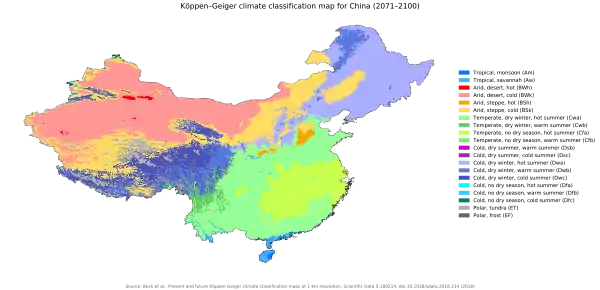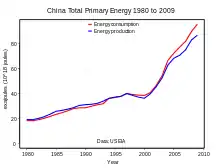Climate change in China
Climate change in China is having major effects on the economy, society and the environment.[1] China is the largest source of carbon dioxide emissions, through an energy infrastructure heavily focused on fossil fuels and coal. Also, other industries, such as a burgeoning construction industry and industrial manufacturing contribute heavily to carbon emissions. However, like other developing countries, on a per-capita basis, China's carbon emissions were considerably less that countries like the United States: as of 2016, they were the 51st most per capita emitter.[2]
.png.webp)
China is suffering from negative effects of global warming in agriculture, forestry and water resources, and is expected to continue to see increased impacts. China's government is taking some measures to increase renewable energy, and other decarbonization efforts, vowing to be carbon neutral by 2060 by adopting “more vigorous policies and measures.”[3]
Effects of climate change
China has and will suffer some of the effects of global warming, including sea level rise, glacier retreat and air pollution.
China's first National Assessment of Global Climate Change, released in the 2000s by the Ministry of Science and Technology (MOST), states that China already suffers from the environmental impacts of climate change: increase of surface and ocean temperature, rise of sea level.[4] Qin Dahe, former head of China's Meteorological Administration, has said that temperatures in the Tibetan Plateau of China are rising four times faster than anywhere else.[5] Rising sea level is an alarming trend because China has a very long and densely populated coastline, with some of the most economically developed cities such as Shanghai, Tianjin, and Guangzhou situated there. Chinese research has estimated that a one-meter rise in sea level would inundate 92,000 square kilometers of China's coast, thereby displacing 67 million people.[6]
Changing weather and water
There has also been an increased occurrence of climate-related disasters such as drought and flood, and the amplitude is growing. These events have grave consequences for productivity when they occur, and also create serious repercussions for the natural environment and infrastructure. This threatens the lives of billions and aggravates poverty.
China observed a ground average temperature increase of 0.24℃/decade from 1951 to 2017, exceeding the global rate. The average precipitation of China was 641.3 mm in 2017, 1.8% more than the average precipitation of previous years. The sea level rise was 3.3mm/year from 1980 to 2017. There was an annual increase in concentrations of carbon dioxide from 1990 to 2016. The annual mean concentration of atmospheric carbon dioxide, methane, and nitrous oxide at Wanliguan Station were 404.4 ppm, 1907 ppb, and 329.7 ppb separately in 2016, slightly higher than the global mean concentration in 2016.[7]
Furthermore, climate change will worsen the uneven distribution of water resources in China. Outstanding rises in temperature would exacerbate evapotranspiration, intensifying the risk of water shortage for agricultural production in the North. Although China's southern region has an abundance of rainfall, most of its water is lost due to flooding. As the Chinese government faces challenges managing its expanding population, an increased demand for water to support the nation's economic activity and people will burden the government. In essence, a water shortage is indeed a large concern for the country.[6]
Public health
Lastly, climate change could endanger human health by increasing outbreaks of disease and their transmission. After floods, for example, infectious diseases such as diarrhea and cholera are all far more prevalent. These effects would exacerbate the degradation of the ecologically fragile areas in which poor communities are concentrated pushing thousands back into poverty.[8]
Some regions in China will be exposed to a 50 percent higher malaria transmission probability rate (Béguin et al., 2011).[9]
Agriculture
The negative effects on China's agriculture caused by climate change have appeared. There was an increase in agricultural production instability, severe damages caused by high temperature and drought, and lower production and quality in the prairie. In the near future, climate change may cause negative influences, causing a reduction of output in wheat, rice, and corn, and change the agricultural distribution of production.[10] China is also dealing with agricultural issues due global demands of products such as soybeans. This global demand is causing coupled effects that stretch across oceans which in turn is affecting other countries. Environmental factor#Socioeconomic Drivers
Forest and other natural ecosystems
Climate change increases forest belt limits and frequencies of pests and diseases, decreases frozen earth areas, and threatens to decrease glacial areas in northwest China. The vulnerability of ecosystems may increase due to future climate change.[10]
Water resource and coastal zone
Climate change decreased total water resources in North China while increasing total water resources in South China. There were more floods, drought, and extreme weather events. There may be a big impact in the spatial and temporal distribution in China's water resources, increasing extreme weather events and natural disasters. Climate change caused an increase in sea level, threatening to impair the functions of harbors.[10]
.jpg.webp) Yellow Sea
Yellow Sea.jpg.webp) Shanghai
Shanghai.jpg.webp) Tianjin and Yingkou
Tianjin and Yingkou
Present and future Köppen-Geiger climate classification maps


Energy


Ensuring adequate energy supply to sustain economic growth has been a core concern of the Chinese government since 1949.[11] The country is the world's largest emitter of greenhouse gases, and coal in China is a major cause of global warming.[12] However, from 2010 to 2015 China reduced energy consumption per unit of GDP by 18%, and CO2 emissions per unit of GDP by 20%.[13] On a per-capita basis, it was the world's 51st largest emitter of greenhouse gases in 2016.[14]
China is also the world's largest renewable energy producer.[15] China is the largest producer of hydroelectricity, solar power and wind power in the world.
Details for the power sector are likely to be released winter 2021/22 for the 14th five-year plan,[16] and this is expected to determine whether the country builds more coal-fired power stations, and thus perhaps whether global climate goals are met.[17]Renewables


| Part of a series on |
| Renewable energy |
|---|
 |
China is the world's leading country in electricity production from renewable energy sources, with over double the generation of the second-ranking country, the United States. By the end of 2019, the country had a total capacity of 790GW [18][19] of renewable power, mainly from hydroelectric, solar and wind power. By the end of 2019, China's hydropower capacity reached 356 GW.[20] China's installed capacity of solar power reached 240 GW in 2020.[21] As of Q3 2020, China's wind power capacity was 224 GW.[22] China's renewable energy sector is growing faster than its fossil fuels and nuclear power capacity.
Although China currently has the world's largest installed capacity of hydro, solar and wind power, its energy needs are so large that in 2019, renewable sources provided 26% of its electricity generation[23] -- compared to 17% in the U.S.A.[24] -- with most of the remainder provided by coal power plants. In early 2020, renewable energy comprised about 40% of China's total installed electric power capacity, and 26% of total power generation -- with solar and wind combined having more capacity than hydropower.[25] Nevertheless, the share of renewable sources in the energy mix had been gradually rising in recent years.
China sees renewables as a source of energy security and not just only to reduce carbon emission.[26] China's Action Plan for the Prevention and Control of Air Pollution issued by China's State Council in September 2013, illustrates the government's desire to increase the share of renewables in China's energy mix.[27] Unlike oil, coal and gas, the supplies of which are finite and subject to geopolitical tensions, renewable energy systems can be built and used wherever there is sufficient water, wind, and sun.[28]
As Chinese renewable manufacturing has grown, the costs of renewable energy technologies have dropped dramatically. Innovation has helped, but the main driver of reduced costs has been market expansion.[28] In 2015, China became the world's largest producer of photovoltaic power, with 43 GW of total installed capacity.[29][30] From 2005 to 2014, production of solar cells in China has expanded 100-fold.[28]
However, China is not expected to achieve grid parity – when an alternate source of energy is as cheap or cheaper than power purchased from the grid—until 2022.[31] In 2017, investments in renewable energy amounted to US$279.8 billion worldwide, with China accounting for US$126.6 billion or 45% of the global investments.[32]Reactions
Public opinion
According to the Chinese citizen climate change recognition and understanding report[33] conducted by the China Climate Change Communication program, 94% of interviewees supported fulfilling the Paris agreement, 96.8% of interviewees supported international cooperation on global climate change, and more than 70% of interviewees were willing to purchase environmentally friendly products. 98.7% of interviewees supported implementing climate change education at schools. Respondents were most concerned about the air pollution caused by climate change. The investigation included 4025 samples.[33]
The investigation showed that Chinese citizens agreed that they were experiencing climate change, and that it was caused by human activities.[34]
Furthermore, most Chinese citizens believe individual action on climate change can help, although the government is still seen as the entity most responsible for dealing with climate change. If the government does take action, fiscal and taxation policies are seen as potentially effective.[35]
Government stance
Climate change has not been a priority to China until recently, when this issue was brought to a higher platform. Chinese state affairs operate as a central system, not a federal system. For example, the central government makes decisions and the local governments fulfill them. As a result, the local governments receive constraints and are measured by their performance from the central governments. Solving environmental issues such as climate change requires long-term investments in money, resources, and time. It is believed that these efforts will be detrimental to economic growth, which is of particular importance to the promotion of local government executives. This is why local governments have no engagement in addressing this issue.[36]
Attitudes of the Chinese government on climate change, specifically regarding the role of China in climate change action, have shifted notably in recent years. Historically, climate change was largely seen as a problem that has been created by and should be solved by industrialized countries; in 2015, China said it supports the "common but differentiated responsibilities" principle,[37] which holds that since China is still developing, its abilities and capacities to reduce emissions are comparatively lower than developed countries'.
Recently, the government has urged countries to continue to support the Paris agreement, even in the wake of the United States' withdrawal in 2017.[38]
On September 22, 2020, Chinese leader Xi Jinping announced at the UN General Assembly in New York that his country will end its contribution to global heating and achieve carbon neutrality by 2060 by adopting “more vigorous policies and measures.”[3]
Policy action
In China's first NDC submission, key areas were identified for climate change adaptation, including agriculture, water resources, and vulnerable areas. It also mentioned that an adaptation strategy should be implemented through regional strategies. [39] Flooding in cities is being tackled by collecting and recycling rainwater.[40] In 2013, China issued its National Strategy for Climate Change Adaptation and set goals of reducing vulnerability, strengthening monitoring, and raising public awareness. Efforts on implementation have been put in adapting forestry, meteorological management, infrastructure, and risk planning. [41]
The development of technology and economy in China share more responsibility in tackling climate change. After facing the 2011 smog issue, China's government launched an extensive strategy, which is to improve air quality by reducing the growth of coal consumption. Nevertheless, the trade war that involved China as one of the leading participants has resulted in the loss of control of polluting industries, especially in the steel and cement during 2018. Fortunately, nearly 70 multinational and local brands implemented the monitoring data by The Institute of Public & Environmental Affairs (IPE) in China, stimulating nearly 8,000 suppliers approaching regulatory violations.[42]
Internally in the provinces of China, there are various projects held aiming to solve emissions reduction and energy-saving, which is a big step in tackling climate change. Beijing is developing in replacing traditional bulbs with energy-saving light bulbs. Provinces such as Rizhao and Dezhou are promoting solar energy in the building heating system. Besides, Tsinghua University launched a lead on low-carbon city development. The city is currently working with Tsinghua University to improve the urban environment by introducing renewable energy into industries and households.[43]
National carbon trading scheme
See also
- China Carbon Forum
- China Beijing Environmental Exchange
- Coal power in China
- Deforestation and climate change
- Environment of China
- Green growth in China
- Politics of global warming
- Renewable energy in China
- Renewable energy commercialization
- Solar power in China
- Scientific Development Concept
- Tianjin Climate Exchange
References
- "China National communication 3: Part III Impacts of Climate Change and Adaptation". unfccc.int. Archived from the original on 14 November 2019. Retrieved 26 September 2019.
- "DataBank - CO2 emissions (metric tons per capita)". The World Bank. Retrieved 10 August 2020.
- "Climate change: China aims for 'carbon neutrality by 2060'". BBC News. Retrieved 22 September 2020.
- http://www.die-gdi.de/CMS-Homepage/openwebcms3_e.nsf/(ynDK_contentByKey)/ENTR-7BDE2T?OpenDocument&nav=expand:Research%20and%20Consulting\Projects;active:Research%20and%20Consulting\Projects\ENTR-7BDE2T%5B%5D
- "The Indus Equation Report, Strategic Foresight Group" (PDF). Archived (PDF) from the original on 28 March 2019. Retrieved 14 August 2013.
- "Digication e-Portfolio :: Eda Charmaine Gimenez :: Welcome". stonybrook.digication.com. Archived from the original on 29 August 2011. Retrieved 26 April 2012.
- 2170. "《中国气候变化蓝皮书》:年平均气温显著上升--人民网环保频道--人民网". env.people.com.cn. Archived from the original on 23 June 2019. Retrieved 10 April 2018.CS1 maint: numeric names: authors list (link)
- "Climate Change Aggravates Poverty". Oxfam Hong Kong. Archived from the original on 15 March 2012. Retrieved 26 April 2012.
- Why a 4 degree centrigrade warmer world must be avoided Archived 9 November 2013 at the Wayback Machine November 2012 World Bank
- "Climate Change in China | Shangri-la Institute". waterschool.cn. Archived from the original on 9 May 2018. Retrieved 15 April 2018.
- Andrews-Speed, Philip (November 2014). "China's Energy Policymaking Processes and Their Consequences". The National Bureau of Asian Research Energy Security Report. Retrieved 5 December 2014.
- McGrath, Matt (20 November 2019). "China coal surge threatens Paris climate targets". Retrieved 9 December 2019.
- Ma Tianjie (6 August 2016). "China's 5 Year Plan for Energy". The Diplomat. Retrieved 30 October 2016.
- "DataBank - CO2 emissions (metric tons per capita)". The World Bank. Retrieved 10 August 2020.
- Alok Jha (1 August 2008). "China 'leads the world' in renewable energy". The Guardian. Retrieved 2 February 2011.
- "Analysis: Will China build hundreds of new coal plants in the 2020s?". Carbon Brief. 24 March 2020. Retrieved 11 September 2020.
- "Guest post: Why would anyone finance another coal power plant in China?". Carbon Brief. 7 September 2020. Retrieved 11 September 2020.
- "Factbox: Achievements in China's energy development - Xinhua | English.news.cn". www.xinhuanet.com. Retrieved 6 January 2021.
- "Renewables – Global Energy Review 2020 – Analysis". IEA. Retrieved 6 January 2021.
- "International Hydropower Association. Country Profile - China". International Hydropower Association - IHA. Archived from the original on 5 January 2021.
- Staff, Reuters (10 December 2020). "China solar capacity growth hits 40 GW in 2020 - official". Reuters. Retrieved 6 January 2021.
- "2020 Q3 Electricity and other energy statistics". China Energy Portal | 中国能源门户. 25 October 2020. Retrieved 6 January 2021.
- "2019 electricity & other energy statistics (preliminary)". China Energy Portal | 中国能源门户. 21 January 2020. Retrieved 6 January 2021.
- "Electricity in the U.S. - U.S. Energy Information Administration (EIA)". www.eia.gov. Retrieved 6 January 2021.
- "2020 Q2 electricity & other energy statistics". China Energy Portal | 中国能源门户. 21 July 2020. Retrieved 6 January 2021.
- Deng, Haifeng and Farah, Paolo Davide and Wang, Anna, China's Role and Contribution in the Global Governance of Climate Change: Institutional Adjustments for Carbon Tax Introduction, Collection and Management in China (24 November 2015). Journal of World Energy Law and Business, Oxford University Press, Volume 8, Issue 6, December 2015. Available at SSRN: http://ssrn.com/abstract=2695612
- Andrews-Speed, Philip (November 2014). "China's Energy Policymaking Processes and Their Consequences". The National Bureau of Asian Research Energy Security Report. Retrieved 5 December 2014.
- John A. Mathews & Hao Tan (10 September 2014). "Economics: Manufacture renewables to build energy security". Nature.
- Reuters Editorial (21 January 2016). "China's solar capacity overtakes Germany in 2015, industry data show". Reuters.
- "Chinese solar capacity outshone Germany's in 2015". businessgreen.com.
- N, Sushma U. "India is beating China in the race to build massive solar power projects". Quartz. Retrieved 22 May 2018.
- Frankfurt School – UNEP Collaborating Centre for Climate & Sustainable Energy Finance (2018). Global Trends in Renewable Energy Investment 2018. Available online at: https://europa.eu/capacity4dev/unep/documents/global-trends-renewable-energy-investment-2018
- "中国公众气候变化与气候传播认知情况调研报告" (PDF). 中国公众气候变化与气候传播认知情况调研报告. November 2017. Archived (PDF) from the original on 18 April 2018. Retrieved 18 April 2018.
- "2017年中国公众气候变化与气候传播认知状况调研报告发布". www.sohu.com. 2 November 2017. Archived from the original on 16 December 2019. Retrieved 10 April 2018.
- Yu, Hao; Wang, Bing; Zhang, Yue-Jun; Wang, Shouyang; Wei, Yi-Ming (22 May 2013). "Public perception of climate change in China: results from the questionnaire survey". Natural Hazards. 69 (1): 459–472. doi:10.1007/s11069-013-0711-1. ISSN 0921-030X. S2CID 140627529.
- Qi, Y., Ma, L., Zhang, H., & Li, H. (2008). Translating a Global Issue Into Local Priority: China’s Local Government Response to Climate Change. The Journal of Environment & Development, 17(4), 379–400. https://doi.org/10.1177/1070496508326123
- "China reaffirms the key principle of 'common but differentiated responsibility'". Archived from the original on 10 October 2019. Retrieved 1 December 2015.
- "China Is a Climate Leader but Still Isn't Doing Enough on Emissions, Report Says". Archived from the original on 22 October 2019. Retrieved 20 November 2018.
- China's First NDC Submissionhttps://www4.unfccc.int/sites/ndcstaging/PublishedDocuments/China%20First/China%27s%20First%20NDC%20Submission.pdf Archived 15 November 2019 at the Wayback Machine
- "China taps into global expertise in climate change battle against increasing floods and drought". South China Morning Post. 9 July 2019. Archived from the original on 26 September 2019. Retrieved 26 September 2019.
- "GUIDE TO CHINESE CLIMATE POLICY 2018" (PDF). Archived (PDF) from the original on 10 January 2020. Retrieved 24 October 2019.
- How China Can Truly Lead the Fight Against Climate Change https://time.com/5669061/china-climate-change/ Archived 10 October 2019 at the Wayback Machine
- Translating a Global Issue Into Local Priority: China’s Local Government Response to Climate Change Qi, Y., Ma, L., Zhang, H., & Li, H. (2008). Translating a Global Issue Into Local Priority: China’s Local Government Response to Climate Change. The Journal of Environment & Development, 17(4), 379–400. https://doi.org/10.1177/1070496508326123
- Swartz, Jeff (March 2016). "China's National Emissions Trading System" (PDF). Global Economic Policy and Institutions.
- Fialka,ClimateWire, John. "China Will Start the World's Largest Carbon Trading Market". Scientific American. Retrieved 3 May 2017.
